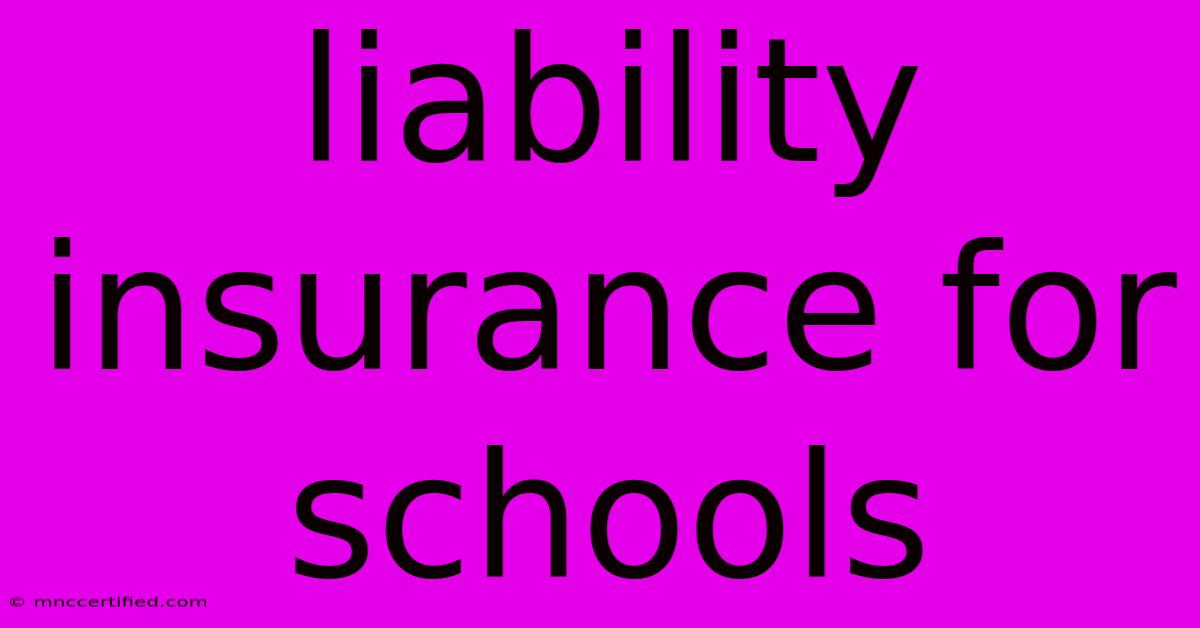Liability Insurance For Schools

Table of Contents
Liability Insurance for Schools: Protecting Students, Staff, and Your Institution
School liability insurance is crucial for protecting educational institutions from the financial devastation of lawsuits and accidents. This comprehensive guide will explore the different types of coverage, the importance of adequate coverage, and how to choose the right policy for your specific needs. Understanding school liability insurance is not just about protecting your budget; it’s about safeguarding your students, staff, and the reputation of your institution.
Understanding the Risks Faced by Schools
Schools face a unique set of risks, making comprehensive liability insurance paramount. These risks can range from:
- Student injuries: Accidents on playgrounds, in classrooms, during sports activities, or on school trips can lead to significant medical bills and potential lawsuits.
- Staff injuries: Workplace accidents, injuries caused by student misbehavior, and even injuries sustained while traveling for school events can expose the school to liability.
- Property damage: Vandalism, fire, theft, or weather-related damage to school buildings and property can result in substantial financial losses.
- Allegations of negligence: Claims of negligence in supervision, inadequate safety measures, or failure to prevent bullying can lead to costly legal battles.
- Sexual abuse or harassment claims: These serious allegations can have devastating consequences, both legally and reputationally.
Minimizing Risks: Proactive Safety Measures
While insurance is vital, proactive safety measures are equally important. Implementing robust safety protocols demonstrates due diligence and can significantly reduce the likelihood of incidents. These measures could include:
- Regular safety inspections: Thoroughly inspect school grounds, facilities, and equipment to identify and address potential hazards.
- Comprehensive safety training: Provide staff with training on emergency procedures, child safety, and risk management.
- Clear policies and procedures: Develop and enforce clear policies on student conduct, supervision, and emergency response.
- Background checks: Conduct thorough background checks for all staff members.
- Well-maintained facilities: Ensure that school facilities are adequately maintained and repaired to prevent accidents.
Types of Liability Insurance for Schools
Several types of liability insurance are crucial for schools:
- General Liability Insurance: This covers bodily injury or property damage caused by school operations, such as a visitor slipping on a wet floor.
- Professional Liability Insurance (Errors and Omissions): This protects against claims of negligence or errors in professional judgment by teachers or administrators, such as failing to provide adequate supervision.
- Umbrella Liability Insurance: This provides additional coverage beyond the limits of your general liability and professional liability policies. It's crucial for substantial claims.
- Workers' Compensation Insurance: This covers medical expenses and lost wages for staff members injured on the job.
- Directors and Officers (D&O) Liability Insurance: This protects school board members and administrators from lawsuits related to their decisions and actions.
Choosing the Right Coverage: Key Considerations
Selecting the right insurance policy involves careful consideration of several factors:
- School size and type: The size and type of your school (elementary, secondary, private, public) will significantly impact your insurance needs.
- Number of students and staff: A larger student and staff population generally necessitates higher coverage limits.
- Activities offered: Schools offering extensive extracurricular activities, field trips, or specialized programs may require additional coverage.
- Location: Schools in high-risk areas may need higher coverage limits to account for increased liability.
Finding the Right Insurance Provider
Securing the appropriate liability insurance requires careful research. Compare quotes from multiple reputable insurance providers specializing in educational institutions. Don't solely focus on price; prioritize the provider's experience, reputation, and the breadth of coverage offered. Consider seeking advice from an insurance broker specializing in education to ensure you're adequately protected.
Regular Review and Updates
Insurance needs can change over time. Regularly review your policy to ensure it continues to meet your school’s evolving needs and risk profile. Consider updating your coverage annually, or whenever significant changes occur within the school, such as expansion, new programs, or changes in staffing.
In conclusion, comprehensive liability insurance is a non-negotiable aspect of operating a school. Protecting your students, staff, and institution requires a proactive approach that combines robust safety measures with adequate insurance coverage. By understanding the risks and selecting the right policy, schools can mitigate financial and reputational damage and focus on providing a safe and enriching learning environment.

Thank you for visiting our website wich cover about Liability Insurance For Schools. We hope the information provided has been useful to you. Feel free to contact us if you have any questions or need further assistance. See you next time and dont miss to bookmark.
Featured Posts
-
Mike Applied For Life Insurance
Nov 24, 2024
-
How To Watch Asu Vs Byu Football
Nov 24, 2024
-
Slater Grande Erivo Emotional Reaction Explained
Nov 24, 2024
-
Live Score Penn State Football Vs Minnesota
Nov 24, 2024
-
Arsenal 3 0 Win Nottingham Forest Report
Nov 24, 2024